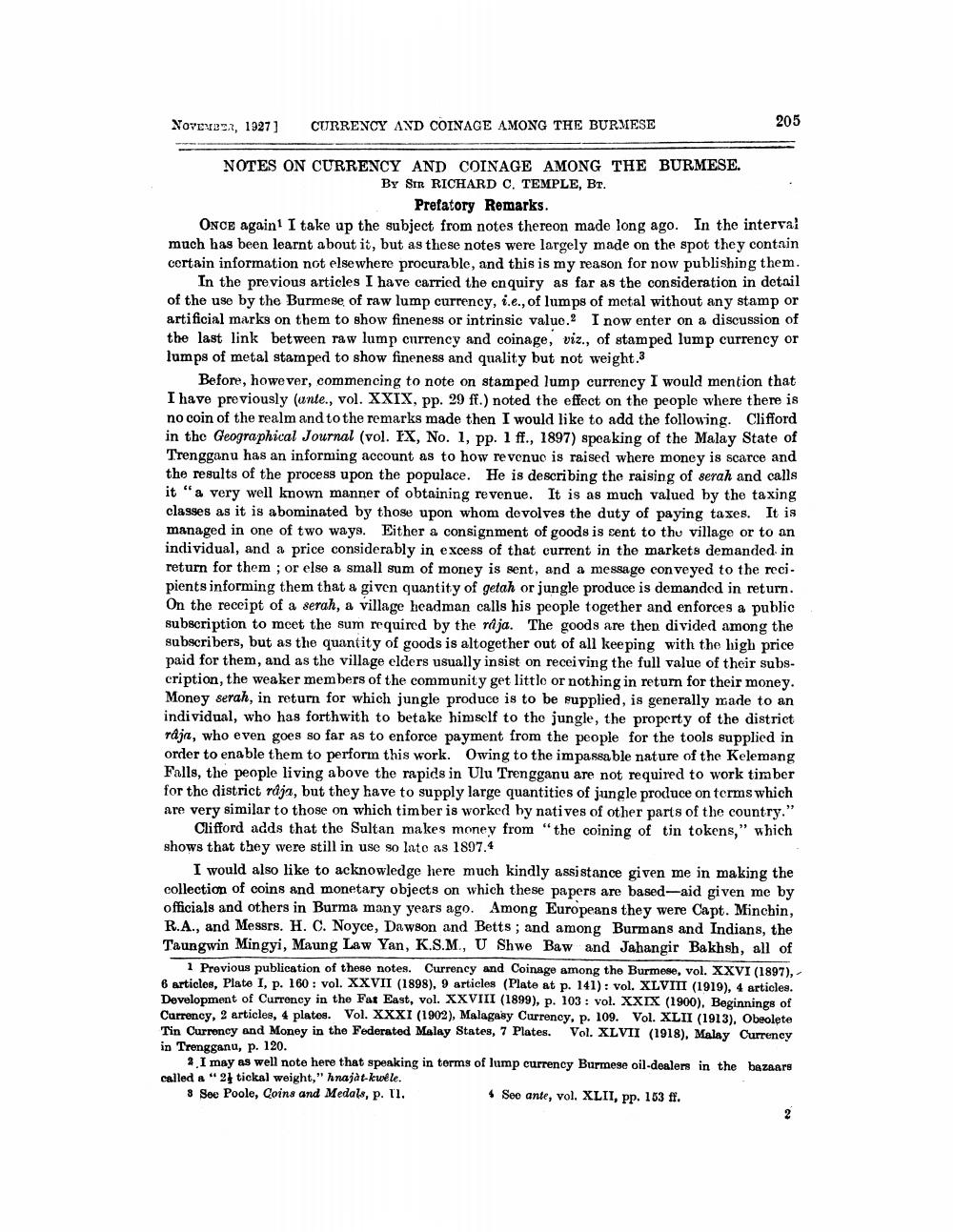________________
NOVEN
, 1027)
CURRENCY AND COINAGE AMONG THE BURMESE
205
NOTES ON CURRENCY AND COINAGE AMONG THE BURMESE.
BY SIR RICHARD C. TEMPLE, Br.
Prefatory Remarks. ONCE again! I take up the subject from notes thereon made long ago. In the interval much has been learnt about it, but as these notes were largely made on the spot they contain certain information not elsewhere procurable, and this is my reason for now publishing them.
In the previous articles I have carried the enquiry as far as the consideration in detail of the use by the Burmese of raw lump currency, i.e., of lumps of metal without any stamp or artificial marks on them to show fineness or intrinsic value. I now enter on a discussion of the last link between raw lump currency and coinage, viz., of stamped lump currency or lumps of metal stamped to show fineness and quality but not weight.3
Before, however, commencing to note on stamped lump currency I would mention that I have previously (ante., vol. XXIX, pp. 29 ff.) noted the effect on the people where there is no coin of the realm and to the remarks made then I would like to add the following. Clifford in the Geographical Journal (vol. EX, No. 1, pp. 1 ff., 1897) speaking of the Malay State of Trengganu has an informing account as to how revenue is raised where money is scarce and the results of the process upon the populace. He is describing the raising of serah and calls it "a very well known manner of obtaining revenue. It is as much valued by the taxing classes as it is abominated by those upon whom devolves the duty of paying taxes. It is managed in one of two ways. Either a consignment of goods is sent to thu village or to an individual, and a price considerably in excess of that current in the markets demanded in return for them; or else a small sum of money is sent, and a message con veyed to the reci. pients informing them that a given quantity of getah or jungle produce is demanded in return. On the receipt of a serah, a village headman calls his people together and enforces a public subscription to meet the sum required by the raja. The goods are then divided among the subscribers, but as the quantity of goods is altogether out of all keeping with the high price paid for them, and as the village elders usually insist on receiving the full value of their subscription, the weaker members of the community get little or nothing in return for their money. Money serah, in return for which jungle produce is to be fupplied, is generally made to an individual, who has forthwith to betake himself to the jungle, the property of the district raja, who even goes so far as to enforce payment from the people for the tools supplied in order to enable them to perform this work. Owing to the impassable nature of the Kelemang Falls, the people living above the rapids in Ulu Trengganu are not required to work timber for the district råja, but they have to supply large quantities of jungle produce on terms which are very similar to those on which timber is worked hy natives of other parts of the country."
Clifford adds that the Sultan makes money from "the coining of tin tokens," which shows that they were still in use so lato as 1897.4
I would also like to acknowledge here much kindly assistance given me in making the collection of coins and monetary objects on which these papers are based-aid given me by officials and others in Burma many years ago. Among Europeans they were Capt. Minchin, R.A., and Messrs. H. C. Noyce, Dawson and Betts; and among Burmans and Indians, the Taungwin Mingyi, Maung Law Yan, K.S.M., U Shwe Baw and Jahangir Bakhsh, all of
1 Previous publication of these notes. Currency and Coinage among the Burmese, vol. XXVI (1897), 6 articles, Plato I, p. 160 : vol. XXVII (1898), 9 articles (Plate at p. 141): vol. XLVIII (1919), 4 articles. Development of Currency in the Far East, vol. XXVIII (1899), p. 103: vol. XXIX (1900), Beginnings of Currency. % articles, 4 platos. Vol. XXXI (1902), Malagasy Currency, p. 109. Vol. XLII (1913), Obeolete Tin Currency and Money in the Federated Malay States, 7 Plates. Vol. XLVII (1918), Malay Currency in Trengganu, p. 120.
2.I may as well note here that speaking in torms of lump currency Burmese oil-dealers in the bazaars called "21 tickal weight," hnajat-kuele. 8 See Poole, Coins and Medals, p. 11,
Seo ante, vol. XLII, pp. 103 ff.




